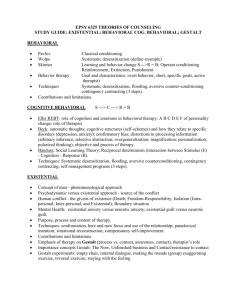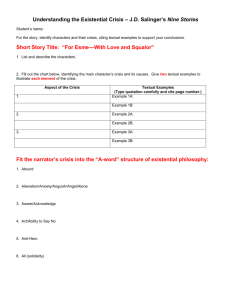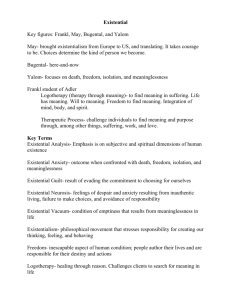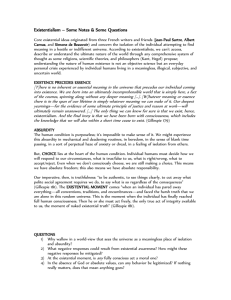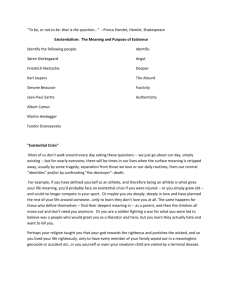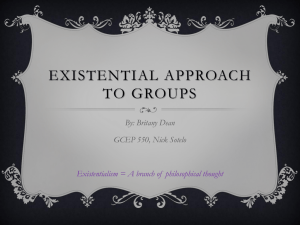St Cloud handout - Charme S. Davidson
advertisement
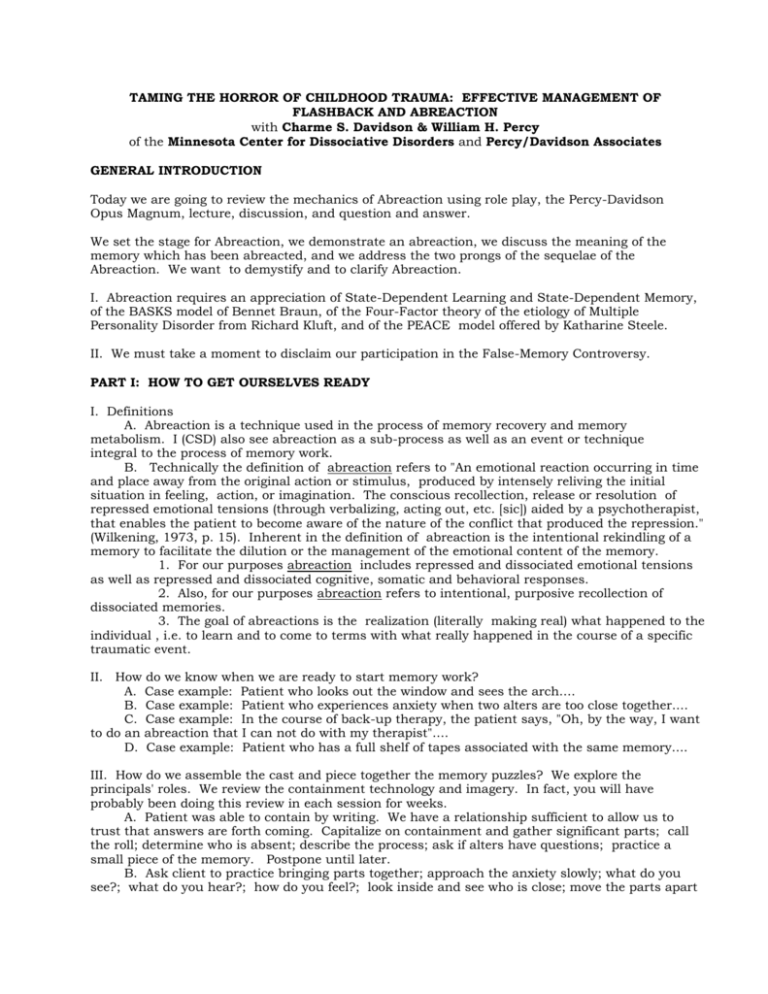
TAMING THE HORROR OF CHILDHOOD TRAUMA: EFFECTIVE MANAGEMENT OF FLASHBACK AND ABREACTION with Charme S. Davidson & William H. Percy of the Minnesota Center for Dissociative Disorders and Percy/Davidson Associates GENERAL INTRODUCTION Today we are going to review the mechanics of Abreaction using role play, the Percy-Davidson Opus Magnum, lecture, discussion, and question and answer. We set the stage for Abreaction, we demonstrate an abreaction, we discuss the meaning of the memory which has been abreacted, and we address the two prongs of the sequelae of the Abreaction. We want to demystify and to clarify Abreaction. I. Abreaction requires an appreciation of State-Dependent Learning and State-Dependent Memory, of the BASKS model of Bennet Braun, of the Four-Factor theory of the etiology of Multiple Personality Disorder from Richard Kluft, and of the PEACE model offered by Katharine Steele. II. We must take a moment to disclaim our participation in the False-Memory Controversy. PART I: HOW TO GET OURSELVES READY I. Definitions A. Abreaction is a technique used in the process of memory recovery and memory metabolism. I (CSD) also see abreaction as a sub-process as well as an event or technique integral to the process of memory work. B. Technically the definition of abreaction refers to "An emotional reaction occurring in time and place away from the original action or stimulus, produced by intensely reliving the initial situation in feeling, action, or imagination. The conscious recollection, release or resolution of repressed emotional tensions (through verbalizing, acting out, etc. [sic]) aided by a psychotherapist, that enables the patient to become aware of the nature of the conflict that produced the repression." (Wilkening, 1973, p. 15). Inherent in the definition of abreaction is the intentional rekindling of a memory to facilitate the dilution or the management of the emotional content of the memory. 1. For our purposes abreaction includes repressed and dissociated emotional tensions as well as repressed and dissociated cognitive, somatic and behavioral responses. 2. Also, for our purposes abreaction refers to intentional, purposive recollection of dissociated memories. 3. The goal of abreactions is the realization (literally making real) what happened to the individual , i.e. to learn and to come to terms with what really happened in the course of a specific traumatic event. II. How do we know when we are ready to start memory work? A. Case example: Patient who looks out the window and sees the arch.... B. Case example: Patient who experiences anxiety when two alters are too close together.... C. Case example: In the course of back-up therapy, the patient says, "Oh, by the way, I want to do an abreaction that I can not do with my therapist".... D. Case example: Patient who has a full shelf of tapes associated with the same memory.... III. How do we assemble the cast and piece together the memory puzzles? We explore the principals' roles. We review the containment technology and imagery. In fact, you will have probably been doing this review in each session for weeks. A. Patient was able to contain by writing. We have a relationship sufficient to allow us to trust that answers are forth coming. Capitalize on containment and gather significant parts; call the roll; determine who is absent; describe the process; ask if alters have questions; practice a small piece of the memory. Postpone until later. B. Ask client to practice bringing parts together; approach the anxiety slowly; what do you see?; what do you hear?; how do you feel?; look inside and see who is close; move the parts apart again; what do you see?; what do you hear?; how do you feel?; look inside and see who is close; what happens to other parts when the anxiety increases; and, wait until tomorrow. C. Gleep. Explore why here and not with therapist; ask who is involved; ask what is needed from the therapist; review rules of grounding and supporting; ask what other therapist would do; try to postpone until more preparation. D. Gather all in meeting room; arrange seating in meeting room; pass out remote controls; load machine; ask who has questions; be sure all are present; explain process; and, wait until tomorrow. IV. How do we schedule abreactions? A. Lead time when possible: at least three weeks. B. Scheduled time: longer session than usual to allow for the technique to fall apart and come back together. 1. Schedule at least three hours for the first abreaction. 2. Later abreactions get scheduled based on experience of earlier ones. 3. Time frames are often situation specific to the memory. C. The abreaction must be undertaken seriously but not too seriously. V. How do you prepare the office? Make safe: move potentially dangerous things; rearrange furniture; have blankets to contain. Have scrap basket (barf bag) available; bring towels as necessary; bring water (drink) and food as necessary; wear comfortable clothes; bring stuffed animals, as necessary; have secretary hold calls; prepare other office members for potential problem, like noise (particularly for first abreaction); have back-up; turn on white noise machine; check distractions. Pee before you begin. VI. What other preparations? Review disaster plan. What of hospitalization? Who is driving? (After trance sessions how oriented is client?) Does patient need a ride? Where is the car parked? Do you need to take time to cool down? Does patient need to take time to cool down? Who will be at home later? What expectations will be had for patient later? Who do you talk to later? VII. Questions, answers, and role play. PART II. The Abreactive Session Itself I. Introduction: A. Dominating Metaphors of "ab-reaction." 1. Catharting: liberating pent-up feelings and emotions. 2. Integrating: re-associating dissociated material. 3. Birthing: a dramatic event in a longer process of bringing new life. B. Our focus is technical. We will approach the abreaction in a linear fashion -- beginning, middle, end -- with emphasis on what to do. C. "We" usually refers to the client-and-therapist team. It may sometimes refer pragmatically to the client alone. II. At the threshold: Pre-liminaries. A. Preparations of the setting : safe space, pillows, chairs, etc. B. Support team, safety plan, drivers in place, as needed. C. Props: blankets, stuffs, water, food, etc. III. The "Warm-up." A. Settling-in. B. Discussing the work we will do. (Use client's familiar language from the preparation period.) 1. Briefly name the tactics for: How we start. How we stay anchored -- breathe, relax, etc. How we make temporary stops for clarification, rest, safety, potty-breaks, etc. Review prearranged signals. Review and discuss safety arrangements, planned or anticipated. (If some unexpected safety problem emerges at this last minute, do not hesitate to hold off or even postpone ABREACTION © Minnesota Center for Dissociative Disorders, 1993 page 2 the abreaction.) Review the stopping procedure already practiced. Review the "frame notion" or any metaphor we have developed for objectifying the memory. Our Most Common Frame for Objectifying the Memory: "Videotape." The "videotape room" or "viewing area" with all its accouterment is a "frame." It exists within a larger frame, namely the therapy office itself in the here-and-now. The events and time-frame of the memory itself, as they are relived, form a third frame within the viewing area frame which is itself within the office-in-the-present frame. Thus, the in-the-past-memory frame is the farthest from the here-and-now, and the viewing area is intermediate. So when we must stop a memory for any reason, if the client has become deeply engaged and is largely in the memory frame, it is easier to bring him/her back to the viewing-area-frame first, then bring her/him back to the present in the office. 2. Assemble all alters in pre-arranged arrays. Inquire about helpers being in place, ask alters with tasks if they are ready, and request last-minute questions. a. Some clients/alters will express cold feet at about this time. Reassurance is helpful. b. Do not rush the warm-up. It is not unusual for it to last for up to 25% of the session. Kluft suggests devoting the first third of the session. IV. Starting the Memory (Here, as everywhere, explain everything as you go. Make no assumptions!) A. Ask the host to review what is known of the memory to date. (Retelling often starts the abreaction; nothing wrong with going ahead.) 1) Our usual technique is to assemble all involved in the "videotape" or "viewing area," and, at this point, to have someone insert the tape. (This will have been practiced in the preparation period, when tapes were reviewed partially, fast forward, etc.). a) The host is usually positioned so that s/he can report to therapist on the abreaction (which in the mind's eye proceeds in the viewing area). b) When the host presses the "play" button, the abreaction usually begins. 2) If not, a variety of hypnotic or quasi-hypnotic techniques usually start the memory. Be sure to have dealt with the problem of inadmissibility of evidence obtained during hypnosis, if client anticipates legal action. Informed consent form is necessary. a) If they are in the "viewing area," they are in the middle-frame. The immediate task is to get them into the memory-frame itself, further away from office and the here-and-now, yet connected to it. A variety of images can help: a golden rope, etc., etc. But move them into proximity with the memory. The most common ways are: The affect bridge. The event bridge (a variant of the affect bridge). Time travel. b) Bill usually goes back to "two minutes before" the event began, then pause. 3) Now you and client are poised at "two minutes before" the event. Reassure everyone. Once again check to make sure all are ready. (N.B. In doing this, you are bringing them back closer to here-and-now. This is good. It tests the connection with the present. It is essential not to let this break during the abreaction, which follows next.) V. The "Abreaction" Proper. A. A review of the therapist's tasks: 1. "The good waiter:" helping without being obtrusive. 2. "The good anchor:" keeping client in present without stopping the flow from the past. a. by simple repeated questions: Situation ABREACTION © Minnesota Center for Dissociative Disorders, 1993 Questions page 3 Client is silent Client settles down after hard scene, appears to stop Client gets stuck, lost, confused, can't describe what's going on, etc. Client panics, losing control Client seems to lose contact with present "What are you experiencing now?" "What is happening now?" "What do you experience next?" "What happens next?" "What do you see/hear/feel/taste/ and so on?" "What do you need to do to calm yourself/get from me/etc.?" "Can you hear/see/feel me//my office/your clothes, etc.? b. by using oft-practiced anchoring tactics. 3. Assemble the BASKS. a. by simple repeated questions: Element of BASK Behavior Affect Sensation Knowledge Spiritual Type of Question How does your body act? What did your body do just then? What emotions do you have? How do you feel just now? (OK to name-as-a-question: Do you feel scared now?) How does your body feel just then? What physical feelings? Where? How? What do you think is happening? What are you thinking here? etc. Where is god? (Client is usually telling you.) b. Reassemble the BASKS by replaying each scene until the BASKS assembles. Return to the "viewing area," stop tape, rewind; take a breather, start again. 4. Keep things moving if there are no "stop" signals. Why Things Get Stuck Shame or denial Too present, not in trance Fear to go ahead External interruption Excessive confusion Unexpected developments (e.g., new alters, weird turn of events) What to Do Name it, support, remind it is part of memory, ask to move on. Name it, induce relaxation, shift to next-deeper frame, then next, till back in memory Name it, OK it, support, ask to move on. Name it, poll troops for anxiety, settle them down, ask to move on. Stop, back up, discuss the details, try again. Stop, discuss. Assess wisdom of moving on, or need to stop and deal with the new material cognitively. 5. Temporarily stop the action if there are "stop" signals. a. The common "stop" signals: Any agreed-on ideodynamic signals. Non-intrinsic confusion or being lost. Non-intrinsic rapid switching or other decompensation. Non-intrinsic flooding of affect or memory. Abreaction becomes flashback (uncontrolled). Client loses connection with present. "Looping" of scene. 30 minutes prior to scheduled end of session. b. Common stopping procedures: Re-establish a conscious connection with therapist, even if client remains disoriented. Explain need to stop for break. Ask permission to stop for break. (Often client will think you are there with him/her. Simple reassurance is usually enough to proceed.) Direct client/system's attention to next-larger frame -- "From the memory where you are now, this is just a memory, remember the viewing area? Remember? The big chair? You are sitting in the big chair in the viewing area? The remote control? You have it in your hand. See it? Look." etc. --. ABREACTION © Minnesota Center for Dissociative Disorders, 1993 page 4 When client/system is "settled" in next-larger frame, direct their attention to the next-larger frame yet, and so on. Stop this process when client is back in conscious connection with you in the here-and-now. It usually is enough to get back to the viewing area. At each level, pause and inquire about everyone. Make sure all are following the process of stopping. Go as slowly as necessary. Sometimes, a small alter or fragment will stay "stuck" in the memory time; you will need to pay direct attention, call to it, get it to talk with you, etc. THEN you can move the whole system to the next-larger frame. c. Once present-connection is restored, discuss the reason for the "stop" signal, what to do about it, etc. If it threatens the abreaction, go to the premature stop (below, section 5.A.) If it doesn't, you should return to the abreaction. 6. Identify the "existential crisis" a. Listen to words the client uses that signify existential "themes" -- death vs. life, freedom vs. slavery, responsibility and guilt, isolation and alienation, anxiety and basic terror, abandonment/rejection (human), disgrace (abandonment/rejection by God). Existential Crises Death vs. life Freedom vs. slavery Responsibility and guilt Isolation and alienation Anxiety Abandonment/rejection (human) Disgrace (abandonment by God) Typical locutions for Existential Crises "going to die." "can't live with this" "trapped," "had to" "could not' stop it" "my fault," "bad" "dirty" "sinner" "all alone" "nobody helped me" "afraid" "terrified" "no one loves me" "they hate me" "God hates me" "G. could never love me" "there's no god for me." b. When you hear the "existential theme," state it back in client's words: "You felt you were going to die." (Do not paraphrase at this point. Client is in very concrete cognitive process. Use his/her words. "Lock in" the client's words for later use. I try to jot them down.) 7. How to know the abreaction is finished (not a premature ending). a. There is a clear sense of being done. A calming of the storm. The energy subsides. It does not feel like repression. b. The client calms, system wide. There is a clear sense, usually reported, of deep fatigue or weariness. c. There may be (not always) a temporary sense of wholeness, of co-presence, as the alters cluster together in the aftermath. This is a precursor of integration. It usually is a peaceful, loving moment, but not invariably. d. The dominant affect-set is usually context-appropriate. Most often, it is some mix of sad, angry, tired, and momentarily whole or proud. Usually there is grief or its early signs. e) It is possible to identify a clear and obvious "climax," in which the client "exploded" in the present -- with rage, grief, terror, knowledge, existential anxiety, etc., etc. -when the composite knowledge and affect of the whole event came together in a present catharsis: the traditional abreaction. (Some believe that there can be internal abreactions, which are not visible to the therapist. Thus, there is no clear evidence of this "explosion." This position is controversial.) VI. The "Cool-down." A. Pre-mature ending: Follow the "stopping" procedure above: 1. Re-establish a conscious connection with therapist, even if client remains disoriented. 2. Explain need to stop. 3. Ask permission to stop. ABREACTION © Minnesota Center for Dissociative Disorders, 1993 page 5 4. Direct client/system's attention to next-larger frame. (State: "From the memory where you are now, this is just a memory, remember the viewing area? Remember? The big chair? You are sitting in the big chair in the viewing area? The remote control? You have it in your hand. See it? Look." etc.) 5. When client/system is "settled" in next-larger frame, direct their attention to the next-larger frame yet, and so on. 6. When client is "back" in viewing area, take few moments to put the memory completely back on the tape for work later. Store the tape as usual. 7. Make sure all alters/ parts are following the process of stopping. 8. When client is back in conscious connection with you, and tape is stored, reverse any steps taken to get into trance. Bring entire client/system out of trance, back to the here-andnow. 9. Take any necessary time to allow entire client to re-orient to time, place, person, self, etc. Pay attention to his/her "getting back" into the body. 10. Go as slowly as necessary. 11. Positively affirm the stopping, the success achieved, the new information discovered, and the client's hard work. Discuss the client's condition. Attend to any problems that are at hand. 12. Discuss the likely complications of the next few hours and days, when to check in, how to manage flashbacks, etc. 13. MAKE PLANS FOR NEXT SESSION AND FOR WHEN THE MEMORY WILL BE ABREACTED AGAIN. (This may be delayed until the client is in sufficiently conscious shape to participate.) 14. If hospitalization is needed, arrange. B. Successful ( or non premature) ending: 1. Usually the client is present, sad, weary, relaxed, temporarily whole or co-conscious, etc. There is a natural "coming out" of the trance and an ending of the abreaction. It "runs out of steam," or "runs its course." 2. The client is no longer in trance. The system is largely co-conscious. 3. Inquire about the status of all alters and parts. If any are stuck in trance or in unfinished memory: a) If time remains, join them where they are and finish the abreaction with them. b) If no time remains, follow the pre-mature ending procedure with the alter in question. 4. Briefly review what was learned, the existential crisis, etc. 5. Discuss the likely post-abreaction reactions: a) physical and emotional reactions. b) need to rest, eat, etc. c) need to check in with therapist. Plans for doing so. 6. Post-session plans. Date of next meeting (when debriefing or processing will begin). 7. Final affirmation. 8. Closure. PART III: METABOLIZING THE POISON OF NOXIOUS MEMORIES INTRODUCTION TO THE METABOLIC PROCESS I. We Recap the experience of the abreaction. A. The Context: After the long preparation, and the Dies Irae, the client returns and carries on in therapy. What happens in the following sessions? Is everything "finished" after the abreaction session itself? B. We are now dealing with the final element of abreaction: Empowering the Client. 1. A variety of movements are cultivated: from "victim" to "survivor"; from past-focus to present and future-focus; from dissociated to integrated BASKS elements; from disowning to appreciating the self; toward resolution of distorted cognitive frames; toward a deeper comfort with affect; toward a new sense of identity and lost or buried dreams. 2. Post-abreactive work centers around two great themes: feelings and meanings. ABREACTION © Minnesota Center for Dissociative Disorders, 1993 page 6 a) Rage, grief, sorrow, guilt, etc. b) What did this all mean? Who am I now? How did this "fit" into the contexts of my life? How does this add texture to those contexts? What does this mean about my future? About my relationships? About sex and love? About hope? About abandonment and loss? And so on. . . C. During the abreaction session itself, we tried to identify the "existential crisis." Now, in the "metabolizing" period, we try to work on this theme or set of themes that have come to define the client's life-style or "intentionality." 1. Steele (1990) speaks of the "traumatic triad" of hopelessness, meaninglessness, and terror which constitutes the "existential crisis" induced in the abuse event and forming the "target" for the abreaction. 2. In this existential crisis, the child formed basic cognitive structures for processing information throughout life -- distorted structures. The affects tied to these are alleviated during the abreaction, but the untangling, processing, and re-structuring of new cognitive frames takes place in the period following the abreactive session. II. Looking ahead: We organize for "metabolizing" noxious memories. A. To do this, we follow a relatively straightforward "map": 1. First, "recover" basic energy & functioning levels. 2. Second, "debrief" the memory extensively. This is both to construct the memory completely, but also to desensitize the client to its intense affect. 3. Third, we "apply" the memory's "existential crisis" (via some phrase usually) to his or her life. We dredge up and then explore the ways in which that learning has affected their attitudes, beliefs, behavior, put them in context them, and apply new frames of meaning. B. Recovery, debriefing, applying is a process not unlike metabolic processing of "raw material" into usable nutrients. Thus our analogy to "metabolizing the noxious memories." PHASE ONE: RECOVERY III. What we usually see in sessions immediately following an abreaction. A. Incomplete abreaction. New material emerging. 1. What to do now? Usually, you can have a second abreaction immediately, unless some contraindication exists. If so, a) Contain (as in the pre-abreaction phase), if necessary. b) Map the new material (if any), prepare for a second abreactive sessions. c) Then have the next abreaction. d) Metabolize the memory (see below). B. New memories may be triggered, or older, unprocessed or unfinished memories set off. 1. Usually, it is best to store and contain it for later work. 2. Care should be taken to explain the need for this to relevant alters. 3. Client will feel intense grief, depression, shame, rage., etc. Here the problem may be that client is not able to tolerate the intensity of the affect. Numerous affect-reduction techniques can be used to modulate the affect while the memory is metabolized. a. Reframe: Normal response to a terrible experience, both then and now. b. Evaluate the severity as if the client had actually experienced the trauma on the day of the abreaction (that is, if one is raped on a Tuesday, it is appropriate to be highly distressed on the following Tuesday, etc.) c. Never expect recovery and happiness in the days after an abreaction. When it happens, rejoice! (Just because you feel relief does not mean the client does.) 4. Manage the symptoms appropriately. (But expect severity and do not overintervene.) 5. Provide support, empathy, connection during the immediate post-abreactive period. 6. Attempt debriefing as soon as the client can tolerate it. But if intolerable, put off till next session, etc. Usually, within a week or two, client can tolerate initial debriefing. ABREACTION © Minnesota Center for Dissociative Disorders, 1993 page 7 Teach affect-modulation techniques during the early phases of therapy (pre-memory work), allowing much time for practice and revision. NOW, during phase three (Percy-Davidson Model, 1993) is not the time for this work. E. You both may note emerging wholeness, co-consciousness, blurring of alters (if abreaction was both complete e and final (in the sense of the "last" memory the alter in question carried). F. You may see partial integration, new sense of connection, belonging, or some similar kind of relatedness among the alters involved in the abreaction. (Even with significant integration, even fusion of alters, do not omit processing the abreaction. The single-minded client needs to process the newly remembered trauma and to develop new cognitive and affective frames and understandings, just as much as the person with multiple personality.) PHASE TWO: DEBRIEFING Expect, when processing the memory, to use all your toolbox of "distancing" techniques even after successful abreactions. The client may or may not be ready to discuss the memory without affective overload, intense shame, etc. One aim of this phase is desensitization. IV. Debriefing the abreaction: we begin to discuss the memory and the abreaction without the intrusion of the dissociative phenomenon. A. Initiate talk about the abreaction itself. Discuss its impact, feelings about it, how it felt afterward, etc. Partly this allows you to find what has happened in the interval, how complete the abreaction appears to be, and so on. Partly, it serves to re-orient everyone to the fact that "we are still working on this memory." B. Begin the debriefing by outlining together the main points of the memory: 1. Stick to the time-line, take things in order. 2. Go for details. 3. Do not pass over cloudy or confused passages. Work carefully on them. They may contain unfinished or still-dissociated material. C. Help the person tell and re-tell the story as often as necessary to desensitize it. Use various distancing or objectifying techniques to help with this. D. In the debriefing process, new material usually emerges. Often this is manageable, but it can trigger a new flashback/abreaction. If it does: 1. Obtain an agreement to abreact it. 2. Make sure there is no contraindication to abreacting the new segment. Contraindications to Abreacting a Flashback or Indications for Containing It (Steele, 1990.) 1. Going ahead would retraumatize the client. 2. Client has insufficient ego or physical strength, cannot stay oriented, cannot stay grounded in present. 3. Client unable to modulate the intensity of the experience and so cannot learn from it. 4. There is insufficient preparation to provide a linear and cognitive frame (a "story line") for the emergent memory. 5. There is insufficient time in which to complete the segment. 6. The therapist is physically, psychologically, or spiritually unready to assist with the abreaction. 7. Any other criterion for having a planned abreaction cannot be met. 3. If inappropriate to abreact, contain. Otherwise, do the new abreaction. Often this will take the remainder of the session. Sometimes, if the memory is way too long (you will have known this, most likely, from the preparation period), you will need to schedule a series of abreactive sessions. E. Piece together the scenario of the memory, moment to moment. Retelling it repeatedly allows it to become a story. With each retelling, focus much attention on the existential crisis. ABREACTION © Minnesota Center for Dissociative Disorders, 1993 page 8 PHASE THREE: EMPOWEREMENT OR "APPLYING THE LEARNING" V. We set to resolve the existential crisis. A. During the abreaction itself, when the client reached the existential crisis and discharged the affect around it, its intensity should have begun to decline naturally. Now, it is time to begin placing in new contexts the learning and understandings imprinted during the original abuse. 1. Some of these will have been prepared during previous therapy, e.g., In the case of "Bill," it was clear that there was a need for a "female" part, Jacquelyn. After the abreaction, it is clear why: In order to "not have a penis," which in turn was necessary in order to believe "he couldn't really hurt me." The abreaction places previously understood needs or beliefs in a new context. 2. Some of these will have emerged during the abreaction itself. For instance, "Bill" spontaneously realizes why he "stopped wanting to serve Mass after I was nine years old." 3. Steele (1990), borrowing from Calof (1987), talks of "negative injunctions" being imprinted during abuse experiences; these form the basis for distorted cognitions. It is these injunctions which need to be reframed and repaired. B. Negative injunctions must be elicited and discussed in the new context of the memory. The injunctions, because their origins are shrouded in dissociation, are powerful and autonomous. The task is to make their clear -- "Oh, he told me he'd kill me if I told anyone!" as the origin of a profound fear of disclosing personal matters of any kind -- and to replace them with new, more appropriate attitudes, beliefs, etc. C. Use the words that the client used (when facing the existential crisis in the abreaction itself). These words are much more potent than the therapist's. Talk about what they mean now (in the aftermath). Process how those particular words have affected the client in years past, and how now. What do they mean to her? How do they now feel? What has she learned about them in the memory? A notable example: Underlying his aggressive behaviors, Jack had the distorted idea that his being nasty and frightening was adequate protection. The result: Alienation (which the host, Bill, could not account for and merely accepted as his lot in life.) These cognitions were due to injunctions from the perpetrator and Bill/Jack's interpretations of his experience at age nine. Only after releasing the extremely powerful affect in the abreaction could Jack see, Aggression didn't really help. In processing this, the therapist would use Jack's words from the abreaction, "Damn it, priest, you can't hurt me -- oh, but he did!" when referring to and processing that "existential moment." VI. Questions used in metabolizing the existential crisis. A. Questions which locate the existential crisis in the memory story or time-line, e.g., How did your feeling that you were going to die make you act when the priest grabbed your penis? Any similarities in your everyday life? B. Questions which probe for new learning, new contexts, new frames of understanding, e.g., what have you learned that is new? How has this memory changed how you think about suchand-such? Do you think your reaction then is related to how you react in life now? C. Questions about meaning, e.g.., What do you think this means? What did this experience cause you to do in life? How do you think this experience affected you with lovers; with your parents; with authority figures; in school; as a worker; etc., etc. (The focal points will, of course, be the types of people or situations with which the client expresses common discomfort.) D. Questions about spirituality, e.g., How has this abuse affected your sense of purpose? of God or a higher power? of faith and hope? of connection to larger causes or goals or purposes? of meaning and truth? of guilt and forgiveness? (Here too, the specific words and language and focal points will be those which the client has discussed in the earlier phases of therapy.) E. Questions about the specific kind of existential crises the person suffered in the memory, e.g., if the existential crisis was about death, questions about death, dying, how thoughts of death are changed by the memory, etc. F. Questions which explore the interconnectedness of the BASKS elements, e.g., When you felt the priest grab your penis and felt all that pain, what emotions did you have? what did you think? etc. ABREACTION page 9 © Minnesota Center for Dissociative Disorders, 1993 VII. Intense affect and ways for you to assist in metabolizing intense affect. A. Rage. Be safe. Be careful. Most importantly, be clear that the affect must be experienced fully, within the limits set to protect the therapy setting, treatment frame, etc. Be cautious with the person who has a history of poor impulse control. Again, experience-undercontrol is the key. Don't worry if there is no "explosion," as long as the client is titrating the rage. B. Shame. Name it. Discuss it. Look especially for its ramifications in life. Do not avoid it or merely reassure the person that he or she is all right. She is not all right. The key -- as with all affect to be metabolized after an abreaction -- is to return to the memory and discuss the existential moments in which the shame was induced. C. Grief. Perhaps a central affect. D. Do not neglect positive affect, learning to identify and feel and express positive affect is critically important in the post-memory work phase of treatment. Accepting joy, forgiveness, healing. VIII. Other "metabolic" issues of empowerment are encountered here. A. Sexuality. Body image and feelings about one's body. Better health, diet, exercise, etc. B. Positive affect. Learning that affect does not destroy. C. Spirituality. D. Alternative methods of stress reduction and management. E. Assertion, relationship skills, discrimination (of perpetrator-types from non-perpetrator types). IX. Common interference arise in metabolizing the memory. A. Other problems crop up and take time. B. Other memories intrude and must be dealt with. C. The client's and the therapist's resistance to discussing the memory in detail. D. Distractions and fatigue. E. Transference. F. Countertransference. SELECTED REFERENCES We will offer other references in the context of the discussion. Calof, D. (1987). Treating Adult Survivors of Incest and Child Abuse. Workshop presented at the Eleventh Annual Family Therapy Network Symposium, Washington, D.C. Percy, W.H. and Davidson, C.S. (1993). Order Out of Chaos: A Five-phase Model for Therapy with Chronic Trauma Survivors. St. Paul, MN: Heartroad Books. (Audiotape and Paper). Steele, K. (1989). A Model for Abreaction with Multiple Personality and other Dissociative Disorders. Dissociation, 2, No. 3. 151-159. Steele, K. (1990). Abreactive Work with Sexual Abuse Survivors. In Hunter, M. (Ed.). The Sexually Abused Male, Vol. 2. New York: Lexington Books. 1-55. ABREACTION © Minnesota Center for Dissociative Disorders, 1993 page 10


